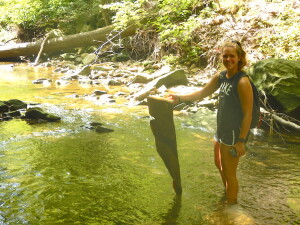Anthropogenic debris and plastic pollution
We are interested in how anthropogenic debris (trash, garbage, litter) makes it way into and through urban streams and from there into receiving bodies of water, like Lake Champlain, the Great Lakes and oceans. Plastic pollution is of growing global concern, particularly because we are not expected to reach peak-plastic for decades to come. While much attention has focused on micro- and nano-plastics, many of these tiny pieces originate from the breakdown of larger plastic materials. In the Watershed Lab, we are interested in understanding the dynamics of trash and plastic, large and small, in diverse aquatic environments.
Ongoing Research
With funding from the National Science Foundation Geomorphology and Land Use Dynamics program, we are working to understand the accumulation and dynamics of trash in urban streams. What aspects of the catchment and stream reach influence where anthropogenic debris accumulates in streams? What controls how mobile the debris is in the stream? Does anthropogenic debris promote scour, deposition, or grain size changes? We will start to answer these questions by drawing upon one-time surveys of trash and geomorphology in 28 stream reaches in Cleveland, Charlotte, and Burlington, and long-term monitoring of large trash and geomorphic change in a Cleveland stream. Nageen Farooq earned a MS on this project, and technician Andrea Stumpf and numerous undergraduate researchers are currently involved.
- Farooq, N., Jefferson, A.J., Greising, C., Kearns, K., Muratori, S., Snyder, K. in review. Prediction of anthropogenic macro-debris and its association with geomorphology in US urban streams.
In 2024, we launched the first comprehensive study of microplastics in the Lake Champlain Basin. In collaboration with Drs. Tim Mihuc and Danielle Garneau at SUNY Plattsburgh, we are measuring microplastics in tributary rivers, along shorelines, and within the lake itself. Nurjahan Begum (University of Vermont) and Alison Morrow (SUNY Plattsburgh) are the grad students on the project.
Recent Research
With funding from Ohio Sea Grant, we investigated plastic dynamics on an urban beach and within the adjacent urban stream in Cleveland, Ohio. This project involved multiple undergraduate researchers at Kent State University.
- Jefferson, A.J., Kearns, K., Snyder, K., Mitchell, A., Muratori, S., Rowan, C.J. in review. Anthropogenic litter and plastics across size classes on a mechanically groomed Great Lakes urban beach.
Volunteer cleanups of streams and beaches have been ongoing for decades and analysis of these records give us insight into how debris characteristics varies across environments and over time. Undergraduate student Azure Fernsler analyzed cleanup data from northeast Ohio streams and beaches for a SURE project in 2020 and her Environmental Studies capstone project in spring 2021. She found that beach cleanups find a higher proportion of plastics and fewer heavy items than stream cleanups, but that there are significant uncertainties in the data that highlight directions for future research. Azure presented her work at the 2020 American Geophysical Union meeting, where she won an Outstanding Student Presentation Award.

